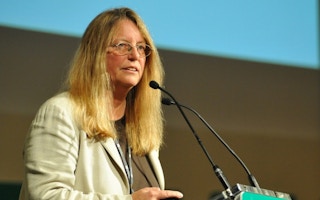Existing technology may be sufficient to meet global renewable energy targets, but political will is lagging behind, said experts at this week’s B4E Global Summit in Jakarta.
In a panel session on renewable energy on the opening day of the summit, Rafael Senga from the World Wide Fund for Nature’s (WWF) Global Climate and Energy Initiative presented the WWF Energy Report outlining how the world can move to 100 per cent renewable energy sources by 2050.
“To meet our energy needs at current levels of consumption, we would need another four Saudi Arabias and another four Russias just to make it to 2030,” he said.
He added that nuclear would not be an acceptable low-carbon energy technology “unless we can work out what to do with the 100,000 tonnes of toxic waste generated each year.”
Wasabi Energy executive director Malcome Jacques said that increasing energy efficiency is a critical way to help achieve a low-carbon economy: “We can reduce consumption globally by 40 per cent today if we increase efficiency.”
“The global recession was the biggest contributor to energy savings in recent time, showing how much it is possible to reduce our consumption,” he added.
Significant investment is needed for the transition to a low-carbon economy, said the panelists. “An upfront investment of 1 trillion to 3.5 trillion is required to meet the 100 per cent renewables target, but there will be net savings if we consider the long term - to 2050,” said Mr Jacques, “Industry will be the first to benefit from these savings.”
Energy efficiency is one way of keeping those costs down. “60 per cent of the energy we put into a power plant goes up the chimney,” he said, “The EU alone could save about 25 per cent of energy by 2020 purely by capturing this waste heat using available technology.”
Sufficient renewable energy technologies are also available, and experts said the costs would come down with enough investment in research. “To meet renewables targets, we will need 75 gigawatts from solar - and this is sufficient motivation for GE to invest in this technology,” said Gatot Prawiro of GE Jenbacher Asia Pacific.
Solar energy is not yet able to meet cost or grid parity with black coal – but this would change as new technologies like GE’s thin film are utilised, said Mr Prawiro. “Right now the technology is ready we just need the cost to go down – it will become competitive as fossil fuels become scarcer and more expensive.”
Grid parity will occur when it will be as cost-efficient to get electricity from the sun as it is from the conventional way of burning fossil fuels.
Geothermal is another form of renewable energy that holds much promise for countries located on the Pacific Rim of Fire, according to WWF’s Mr Senga. He said that WWF hopes to make geothermal the mainstream base-load power source for Indonesia, the Philippines and other Rim of Fire countries like Chile.
In addition, geothermal provides an incentive for the sustainable development of forest communities. “Geothermal delivers enormous benefits to communities. Most geothermal concessions are located in forests and they need a lot of water. If you take away the trees, the water disappears. So the only way to preserve the forests is to involve the local people living around the forests - we call it building the social fence – by recruiting them in protecting the trees.”
He added that geothermal companies are working with WWF in their forest preservation programme.
NGOs and energy technology companies at the summit agreed that there are existing and available solutions for the world’s energy problems that reduced social and environmental impacts - but the remaining barriers are cost and political will.
Eco-Business.com’s coverage of the B4E Global Summit 2011 is brought to you by City Developments Ltd (CDL).















